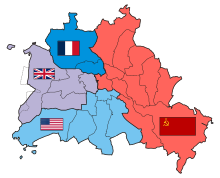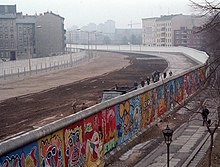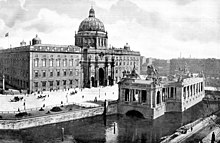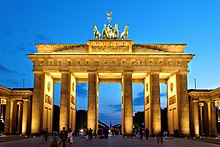Berlin
Berlin (
 [bɛɐ̯ˈliːn]?/i
[bɛɐ̯ˈliːn]?/i) ist
Bundeshauptstadt und
Regierungssitz der
Bundesrepublik Deutschland. Als
Stadtstaat ist Berlin ein
Land und bildet das Zentrum der
Metropolregion Berlin/Brandenburg. Berlin ist mit fast 3,5 Millionen Einwohnern die
bevölkerungsreichste und
flächengrößte Stadt Deutschlands, sowie nach Einwohnern die
zweitgrößte und nach Fläche die
fünftgrößte Stadt der Europäischen Union. Berlin ist in zwölf Bezirke unterteilt. Im Stadtgebiet befinden sich die Flüsse
Spree und
Havel, mehrere kleinere Fließgewässer sowie zahlreiche Seen.
Urkundlich erstmals im 13. Jahrhundert erwähnt, war Berlin im Verlauf der Geschichte Hauptstadt
Brandenburgs,
Preußens und
Deutschlands in seinen verschiedenen Staatsformen. Faktisch war der
Ostteil der Stadt Hauptstadt der
Deutschen Demokratischen Republik. Seit der
Wiedervereinigung im Jahr 1990 ist Berlin
gesamtdeutsche Hauptstadt mit Sitz des
Bundespräsidenten seit 1994, des
Deutschen Bundestags seit 1999 sowie des
Bundesrats seit 2000.
Die Metropole Berlin gilt als
Weltstadt der Kultur, Politik, Medien und Wissenschaften.
[4][5] Sie ist ein wichtiger europäischer
Verkehrsknotenpunkt und eine der meistbesuchten Städte des Kontinents. Institutionen wie die Universitäten, Forschungseinrichtungen und Museen genießen internationalen Ruf. In der Stadt leben und arbeiten Kunstschaffende, Diplomaten und Einwanderer aus aller Welt.
[6] Berlins Geschichte, Nachtleben, Architektur und vielfältige Lebensbedingungen sind weltbekannt.
[7]
Geschichte
Gründung und Mittelalter

Plan Berlins von Abraham Guibert Dusableau (1737,
gesüdet)
Die Stadt
Cölln, Teil der auf der
Spreeinsel gelegenen Doppelstadt
Berlin-Cölln, wurde 1237 erstmals urkundlich erwähnt.
[15] 1244 folgte dann die Erwähnung Berlins, das sich am nördlichen Ufer der Spree befand. Die beiden Städte bekamen 1307 ein gemeinsames Rathaus. Der Name
Berlin hat nichts mit dem Bären im heutigen Stadtwappen zu tun, vielmehr geht er vermutlich auf die
slawische Silbe
berl (Sumpf) zurück. Die heutigen Ortsteile
Spandau und
Köpenick bestanden als slawische Siedlungen bereits vor der Gründung der
Mark Brandenburg, die 1157 durch den
Askanier Albrecht den Bären erfolgte.
Berlin teilte das Schicksal
Brandenburgs unter den Askaniern (1157-1320),
Wittelsbachern (1323-1373) und
Luxemburgern (1373-1415).
1415 wurde
Friedrich I. Kurfürst der
Mark Brandenburg und blieb dies bis 1440. Mitglieder der Familie
Hohenzollern regierten bis 1918 in Berlin, erst als
Markgrafen von Brandenburg, dann als Könige von
Preußen und schließlich als
Deutsche Kaiser.
1448 revoltierten Einwohner von Berlin im „
Berliner Unwillen“ gegen den Schlossneubau des Kurfürsten
Friedrich II. („Eisenzahn“). Dieser Protest war jedoch nicht von Erfolg gekrönt, und die Bevölkerung büßte viele ihrer politischen und ökonomischen Freiheiten ein. 1451 wurde Berlin Residenzstadt der brandenburgischen Markgrafen und Kurfürsten und musste seinen Status als
Freie Hansestadt aufgeben.
Frühe Neuzeit
Der
Dreißigjährige Krieg zwischen 1618 und 1648 hatte für Berlin verheerende Folgen: Ein Drittel der Häuser wurde beschädigt, die Bevölkerungszahl halbierte sich.
Friedrich Wilhelm, bekannt als der
Große Kurfürst, übernahm 1640 die Regierungsgeschäfte von seinem Vater. Er begann eine Politik der
Immigration und der religiösen Toleranz. Vom darauf folgenden Jahr an kam es zur Gründung der Vorstädte
Friedrichswerder,
Dorotheenstadt und
Friedrichstadt.
1671 wurde 50 jüdischen Familien aus
Österreich ein Zuhause in Berlin gegeben. Mit dem
Edikt von Potsdam 1685 lud Friedrich Wilhelm die französischen
Hugenotten nach Brandenburg ein. Über 15.000 Franzosen kamen, von denen sich 6.000 in Berlin niederließen. Um 1700 waren 20 Prozent der Berliner Einwohner Franzosen, und ihr kultureller Einfluss war groß. Viele Einwanderer kamen außerdem aus
Böhmen,
Polen und
Salzburg.
Preußen und das Deutsche Reich
1701 erlangte Berlin durch die Krönung
Friedrichs I. zum König in
Preußen den Status der
preußischen Hauptstadt, den es bis 1945 behielt. Zum 1. Januar 1710 erfolgte die Vereinigung der Städte Berlin, Cölln, Friedrichswerder, Dorotheenstadt und Friedrichstadt zur
Königlichen Haupt- und Residenzstadt Berlin. Bald entstanden neue
Vorstädte, die Berlin vergrößerten.
1861 kam es zur Eingemeindung von
Wedding und
Moabit sowie der
Tempelhofer, der
Schöneberger, der
Spandauer und weiterer Vorstädte.
1871 wurde Berlin
Reichshauptstadt des neu gegründeten
Deutschen Reiches.
Weimarer Republik und Drittes Reich
Nach dem Ende des
Ersten Weltkrieges wurde 1918 in Berlin die
Republik ausgerufen. 1920 folgte mit dem
Groß-Berlin-Gesetz erneut eine umfassende Eingemeindung mehrerer Städte, Landgemeinden und Gutsbezirke rund um Berlin. Die Reichs- und Landeshauptstadt hatte damit rund vier Millionen Einwohner und war in den 1920er Jahren die größte Stadt Kontinentaleuropas und die nach London und New York drittgrößte Stadt der Welt.
Die Stadt erlebte in den 1920er Jahren eine Blütezeit der Kunst, Wissenschaft und Kultur, die später als die
Goldenen Zwanziger bezeichnet wurden. Während dieser Zeit, die zeitweise durch wirtschaftliche Erholung geprägt war, war Berlin die größte Industriestadt Europas.
Infolge der
Machtübernahme der
Nationalsozialisten 1933 wurde Berlin die Hauptstadt des
Dritten Reichs. Die Nationalsozialisten nutzten die 1936 in Berlin stattfindenden
Olympischen Sommerspiele für Propagandazwecke.
[16] Anschließend entwickelten
Adolf Hitler und
Generalbauinspektor Albert Speer gigantomanische architektonische Konzepte für den Umbau Berlins nach römischem Vorbild zur „
Welthauptstadt Germania“.
Die Nationalsozialisten zerstörten
Berlins jüdische Gemeinde, die vor 1933 rund 160.000 Mitglieder zählte. Nach den
Novemberpogromen von 1938 wurden tausende Berliner Juden ins nahe gelegene
KZ Sachsenhausen deportiert. Abgesehen von einigen wenigen Juden, die mit nichtjüdischen Deutschen verheiratet waren, mussten die letzten Berliner Juden ab Februar 1943 während mehrerer Wochen zum
Bahnhof Grunewald marschieren, um in
Viehwaggons in
Vernichtungslager wie
Auschwitz deportiert zu werden.
Während des
Zweiten Weltkrieges wurden große Teile Berlins durch Bomben und durch den Häuserkampf zerstört.
Teilung der Stadt

Karte der geteilten Stadt
Nach der Einnahme der Stadt durch die
Rote Armee und der
bedingungslosen Kapitulation der Wehrmacht am 8. Mai 1945 wurde Berlin gemäß der
Londoner Protokolle – der Gliederung ganz Deutschlands in
Besatzungszonen entsprechend – in
vier Sektoren aufgeteilt. Die Sektoren der Westalliierten (
USA,
Vereinigtes Königreich und
Frankreich) bildeten den
westlichen Teil der Stadt, während der Sektor der
Sowjetunion den
Ostteil bildete.
Für
Groß-Berlin blieb allerdings eine Gesamtverantwortung aller vier Alliierten bestehen. Die zunehmenden politischen Differenzen zwischen den Westalliierten und der Sowjetunion führten 1948/1949 zu einer wirtschaftlichen
Blockade West-Berlins, die die Westalliierten mit der „
Berliner Luftbrücke“ überwanden.
Mit der Gründung der
Bundesrepublik Deutschland im
Westen Deutschlands und der
Deutschen Demokratischen Republik (DDR) im
Osten Deutschlands im Jahr 1949 verfestigte sich der
Kalte Krieg auch in Berlin. Während die Bundesrepublik ihren Regierungssitz in
Bonn hatte, was zunächst als Provisorium gedacht war, proklamierte die DDR
Berlin als Hauptstadt. Der Ost-West-Konflikt gipfelte in der
Berlin-Krise und führte zum Bau der
Berliner Mauer durch die DDR am 13. August 1961.

10. November 1989, Bornholmer Straße im westlichen Teil Berlins. Am Tag nach der
Öffnung der Mauer bereitet ein Spalier Besuchern aus der DDR einen ersten Empfang.
West-Berlin war seit 1949
de facto ein Land der Bundesrepublik Deutschland – allerdings mit rechtlicher Sonderstellung – und Ost-Berlin de facto ein Teil der DDR. Berlins Osten und Westen waren ab 1961 völlig voneinander getrennt; der Übergang war nur noch an bestimmten Kontrollpunkten möglich, allerdings nicht mehr für die Bewohner der DDR und Ost-Berlins, Rentnerinnen und Rentner ausgenommen, und bis 1972 auch nur in Ausnahmefällen für Bewohner West-Berlins.
1971 wurde das
Viermächteabkommen über Berlin unterzeichnet und trat 1972 in Kraft. Während die Sowjetunion den
Viermächte-Status nur auf West-Berlin bezog, unterstrichen die Westmächte 1975 in einer Note an die
Vereinten Nationen ihre Auffassung vom Viermächte-Status über Gesamt-Berlin. Die Problematik des umstrittenen Status Berlins wird auch als
Berlin-Frage bezeichnet.
1989 kam es in der DDR zur
Wende, die Mauer wurde geöffnet. 1990 wurden die beiden deutschen Staaten als Bundesrepublik Deutschland
wiedervereinigt und Berlin per
Einigungsvertrag deutsche Hauptstadt.
Berlim
Origem: Wikipédia, a enciclopédia livre.
-
Berlim (em
alemão Berlin) é a
capital e um dos dezesseis
estados da
Alemanha. Com uma população de 3,4 milhões dentro de limites da cidade, é a maior
cidade do país, além de ser a segunda mais populosa cidade e a oitava mais populosa área urbana da
União Europeia.
[2] Situado no nordeste da Alemanha, é o centro da área metropolitana de Berlim-
Brandemburgo, que inclui 5 milhões de pessoas de mais de 190 nações.
[3] [carece de fontes]
Documentada pela primeira vez no
século XIII, Berlim foi sucessivamente a capital do
Reino da Prússia (
1701-
1918), do
Império Alemão (
1871-1918), da
República de Weimar (
1919-
1933) e do
Terceiro Reich (1933-
1945).
[4] Após a
Segunda Guerra Mundial, a cidade foi dividida;
Berlim Oriental se tornou a capital da
Alemanha Oriental, enquanto
Berlim Ocidental se tornou um
exclave da
Alemanha Ocidental, cercada pelo
muro de Berlim, entre os anos de
1961-
1989, enquanto a cidade de
Bona tornou-se a capital da Alemanha Ocidental.
[5] Após a
reunificação alemã em
1990, a cidade recuperou o seu estatuto, como a capital da
República Federal da Alemanha, sediando 147 embaixadas estrangeiras.
[6][7]
Berlim é um dos mais influentes centros de
política,
cultura e
ciência européia.
[8][9]
A cidade serve como um importante centro do transporte continental e é "casa" para algumas das mais importantes
universidades, eventos esportivos,
orquestras e
museus.
[10] O rápido desenvolvimento da metrópole atraiu uma reputação internacional aos seus festivais,
arquitectura contemporânea e vida nocturna, sendo um grande centro turístico e moradia para pessoas de 180 nações diferentes.
[11][12]
História
Pela primeira vez documentada no
século XIII, Berlim foi sucessivamente a capital do
Reino da Prússia (1701), do
Império Alemão (1871-1918), da
República de Weimar (1919-1932) e do
Terceiro Reich (1933-1945). Depois da
Segunda Guerra Mundial, a cidade foi dividida.
Berlim Oriental se tornou a capital da
República Democrática Alemã (RDA), enquanto
Berlim Ocidental continuou sendo parte da
República Federal da Alemanha (RFA).
[13] Com a
reunificação alemã em 1990, a cidade passou a ser capital de toda a Alemanha.
Primórdios
Alguns séculos a.C., a zona onde hoje se situa Berlim começou a ser habitada por diversas tribos que se estabeleceram nas margens dos rios
Spree e
Havel. No
século VI, diversas tribos eslavas construíram fortificações nas actuais zonas suburbanas de
Spandau e
Köpenick. Por volta do
século XI,
Albrecht, guerreiro saxão da
Casa dos Ascânios, derrota as
tribos eslavas e torna-se o primeiro
Markgraf (
conde) de
Brandemburgo. Por essa altura, estabeleceram-se, nas margens do rio Spree, imigrantes de outras regiões, nomeadamente do vale do
Reno e da
Francónia.
Séculos XIII a XVII

Berlim por volta de
1688 (Desenho de
1835).
O primeiro documento histórico berlinense remonta a
1237, aludindo às povoações de Cölln e Berlim, situadas em cada uma das margens do rio Spree, envolvendo o local onde hoje se situa Nikolaiviertel. As duas localidades aliaram-se em
1307, tendo constituído um município comum.
Com a morte, em
1319, do último governante ascânio, Brandemburgo foi disputada pelas casas de
Luxemburgo e
Wittelsbach, o que originou lutas sangrentas. Em
1414, os habitantes de Berlim, cansados de tanto sofrimento, solicitaram o auxílio do imperador do
Sacro Império Romano-Germânico que lhes enviou, como protector,
Frederico de Hohenzollern, dando origem a 500 anos de domínio da
Casa de Hohenzollern.
Em
1432,
Colônia e Berlim consolidam a aliança de
1307, tendo-se unficado formalmente. Em
1486 tornou-se na sede do eleitorado de
Brandemburgo.
Com a subida, em
1640, de
Frederico Guilherme I de Brandemburgo ao trono de Brandemburgo, a cidade de Berlim desenvolveu-se enormemente, tanto em extensão como em quantidade de
habitantes, atingindo, no final do
século XVII, o número de 20 000. Na segunda metade desse século, Berlim foi fortificada, abriu-se um canal ligando os rios Spree e
Oder e foram plantadas
tílias na
Unter den Linden - hoje uma das mais importantes artérias da cidade, em cujo extremo poente se situa o mais conhecido monumento de Berlim: a
Porta de Brandemburgo.
Séculos XVIII a XIX
No início do
século XVIII, Frederico III de Hohenzollern, sucessor de Frederico Guilherme, transforma Brandenburgo num reino, tendo sido coroado como
Frederico I da Prússia. Berlim passa, então, à categoria de capital prussiana, vendo nascer as Academias de Belas Artes e da Ciência. Edifícios imponentes surgem por todos os lados, se destacando a Zeughaus e o palácio de verão (
Charlottenburg).
No tempo de
Frederico Guilherme I, filho de Frederico I da Prússia, a população de Berlim alcançava os 90 000 habitantes. O rei seguinte,
Frederico II, a transformou numa cidade cultural. Quando da sua morte, nos finais do século XVIII, a população de Berlim atingia os 150 000 habitantes.
No início do século seguinte,
Napoleão Bonaparte vence os prussianos, ocupa Berlim e leva para
Paris a Quadriga que encima a
Porta de Brandemburgo, orgulho da cidade. Com a derrota de Napoleão, a quadriga volta a ser colocada no mesmo local, com grande júbilo da população. Inicia-se, nesta época, a industrialização de Berlim: surge uma fábrica de locomotivas em
1837 e, no ano seguinte, é inaugurada a linha ferroviária entre a capital e
Potsdam. Berlim enche-se de edifícios grandiosos concebidos, na maior parte, por Karl Friedrich Schinkel. Em
1850 Berlim já tinha 300 000 habitantes.

Berlim se tornou a
capital do
Império Alemão em
1871 e expandiu-se rapidamente nos anos seguintes. (Unter den Linden, em 1900).
Em
1861,
Otto von Bismarck, ao ser nomeado chanceler, enceta, a partir de
1864, uma política visando a posicionar a
Prússia à cabeça de todos os estados de língua alemã em detrimento da
Áustria. Para o efeito, a Prússia declarou, sucessivamente, guerra à
Dinamarca, à Áustria e à
França, assumindo o controle de
Schleswig-Holstein, da
Confederação da Alemanha do Norte (associação que englobava 22 estados e cidades livres) e das províncias da
Alsácia e da
Lorena. Em
18 de Janeiro de
1871, Bismark proclama o
Império Alemão, tendo por capital Berlim, e
Guilherme da Prússia como imperador (
Kaiser). A abolição das barreiras comerciais e as indenizações pagas pela França permitiram um enorme desenvolvimento industrial, com o consequente aumento populacional da cidade de Berlim e uma melhoria significativa das infraestruturas urbanas: novo sistema de esgotos (
1876), iluminação eléctrica (
1879) e instalação de
telefones e da primeira linha férrea urbana (
1881).
No início do
século XX, a cidade atingia 1,9 milhão de
habitantes, duplicando esse número volvidos 20 anos. A
Primeira Guerra Mundial não teve um reflexo muito grande sobre a estrutura da cidade.
Em
30 de Janeiro de
1933,
Adolf Hitler foi nomeado chanceler. Hitler desejava demolir e reconstruir Berlim, no projeto conhecido como
Welthauptstadt Germania (
Germânia, a capital do Mundo), o arquiteto proposto para esta nova cidade foi
Albert Speer, porém o projeto nunca seria finalizado. Em 1939 com a invasão da
Polônia, iniciava-se a
Segunda Guerra Mundial que se estenderia até
1945, altura em que a
Alemanha perde a contenda e Berlim é invadida pelo
exército Vermelho. A partir de
1940, Berlim sofreu inúmeros bombardeamentos, especialmente no último ano da guerra, tendo a maioria dos edifícios ficado em ruínas.

O
Muro de Berlim em
1986, com
grafites no lado ocidental. As pessoas que atravessavam a chamada "faixa da morte" no lado oriental corriam o risco de serem baleadas.
Após o fim da guerra, as tropas americanas, britânicas, francesas e soviéticas, reunidas em
Potsdam, dividem a cidade em quatro setores. Berlim viu-se no centro da
Guerra Fria e foi a protagonista de uma de suas maiores crises, conhecida como o
Bloqueio de Berlim (24 de junho de
1948 -
11 de maio de 1949), desencadeada quando a
União Soviética interrompeu o acesso ferroviário e rodoviário às zonas de ocupação americana, britânica e francesa. A crise arrefeceu ao ficar claro que a URSS não agiria para impedir a ponte aérea de alimentos e outros gêneros organizada e operada pelas três potências ocidentais (EUA, Reino Unido e França).
Em
1949 nasce, nos territórios controlados pelos soviéticos, a
República Democrática Alemã, tendo por capital a zona oriental de Berlim. Os restantes sectores de Berlim ficam, assim, a constituir um
enclave dentro do território da RDA. Para evitar a fuga dos berlinenses para os sectores ocidentais, o governo comunista construiu, em
1961, o
muro de Berlim muro com cerca de 150 km de extensão, envolvendo os restantes sectores. Quem tentasse ultrapassá-lo era imediatamente morto.

A queda do muro de Berlim em
1989.
A partir de
1989, as mudanças políticas que ocorrem na
Europa Oriental levaram à queda do muro de Berlim e à abertura das fronteiras entre a
RDA e o restante do território da Alemanha (
RFA).
Em
1990, a Alemanha reunifica-se e Berlim volta a ser a capital, depois de
Bonn ter sido capital provisória da parte ocidental da Alemanha desde os finais da
Segunda Guerra Mundial. De então para cá, a cidade tem vindo a sofrer uma completa transformação urbanística, com a reconstrução e reabilitação de edifícios históricos e a edificação de novos bairros voltados para o
século XXI, aproveitando, especialmente, as zonas anteriormente ocupadas pelo Muro.






















